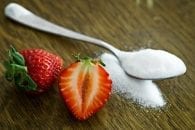Nutritionally speaking, there is no such thing as a bad sugar, since all digestible sugars provide energy to the body. It doesn’t matter to an individual cell whether the glucose it is using for fuel entered the body as a starch or as a sugar. Yet, simple and complex carbohydrates behave differently in the body and are part of different nutritional packages. The best carbs are those that not only provide a steady supply of energy, but also bring other nutrients the body needs. The worst carbs come in packages with few other nutrients, except perhaps fat, and cause the blood sugar, and often a person’s mood, to be unstable.
BEST CARBS
Here’s how to cash in on your carbs. The best source of energy is complex carbohydrates, better known by grandmother’s term “starches.” It takes the body a long time to disassemble these elaborate necklaces of sugar molecules. Enzymes in the stomach work steadily to break the bonds between the sugars until they are changed into simple molecules of glucose, which enter the bloodstream at an even pace. Complex carbohydrates are like a time-released capsule. They provide slow, constant energy, the stomach feels full longer, and the body does not experience the highs and lows of blood-sugar swings.
NUTRITIP: Satisfying Carbs
Beginning a meal with a complex carbohydrate food, such as pasta, and eating it slowly will lessen your craving for fats during the rest of the meal. You’ll start to feel full and won’t want as much of higher-fat foods. So use pasta (with low-fat sauce) to curb overeating.
Complex carbohydrates are found in grains, vegetables, and legumes — foods that provide vitamins, minerals, and fiber as well as energy. You get a lot of nutritional bang for your buck with complex carbs.
NEXT BEST
Fructose sugars are simple monosaccharides rather than complex carbohydrates. They come in packages – fruits – that contain important nutrients and fiber. Fruit sugars provide quick energy, but do not excite the blood sugar roller coaster because the fiber slows absorption of the sugars. Unlike the simple sugar glucose that quickly enters the bloodstream, fructose sugar has to go to the liver before it is released into the bloodstream and carried to the body’s cells. Since fructose is the preferred source of glycogens (sugars stored in the liver), it is a valuable energy food before and after long periods of exercise.
CARBS TO CONSUME WITH CAUTION
Conventional wisdom says that since all carbohydrates are eventually digested and absorbed as glucose, the original food source of the sugar, whether a bean or a candy bar, matters little. Sugar is sugar. Sucrose is sucrose. Not exactly! New insights into how various sugars behave in the body has revealed otherwise. While it is true that the sucrose in an orange is chemically the same as the sucrose in the much-maligned table sugar, the fact that the sucrose in the orange is packaged along with other nutrients makes it behave biochemically more friendly in the body. When you eat sucrose as naturally part of fruits or vegetables, you get not only vitamins and minerals in the package, but you get fiber and other complex carbohydrates that steady the absorption of the sugar. Yet, take the sugar away from the rest of the fruit and vegetable and refine it into a powder, and it’s this processing that downgrades sucrose from the healthy to the junk food category. So, it’s the company the sugar keeps with other foods that affects its absorption from the intestines and its consequent behavior in the body.
To understand why these sugars merit the label “junk sugars,” let’s take a ride with these sugars from the mouth to the bloodstream to see how they affect the body. Junk sugars are called simple carbohydrates because they are short, uncomplicated molecules. Because simple sugars are already so small, they require little or no breaking down in the intestines. The sucrose molecule is quickly broken down into glucose and fructose, and all that glucose is actively pumped through the intestinal cells quickly into the bloodstream. A sprinkle of sugar that hits the intestines enters the bloodstream almost immediately, and the roller coaster ride begins.
After the refined sugars rush into the bloodstream, blood sugar levels rise, pressuring the pancreas to release insulin, the hormone needed to escort these sugars into the body’s cells. Lots of insulin helps the sugar get used up rapidly, but then the blood sugar level plunges. The body hits a sugar low, also known as hypoglycemia or “sugar blues.” Now, just as insulin was released when the blood sugar was too high, other hormones are released when the blood sugar is too low. These stress hormones want to restore the blood sugar to normal levels, so they squeeze stored sugar from the liver, sending the blood sugar back up. These adjustments work better in some people than in others and better in some circumstances than others. Sugar-sensitive individuals experience the ups and downs of blood sugar levels as a roller-coaster ride, and their moods and behavior go up and down with their blood sugar.

